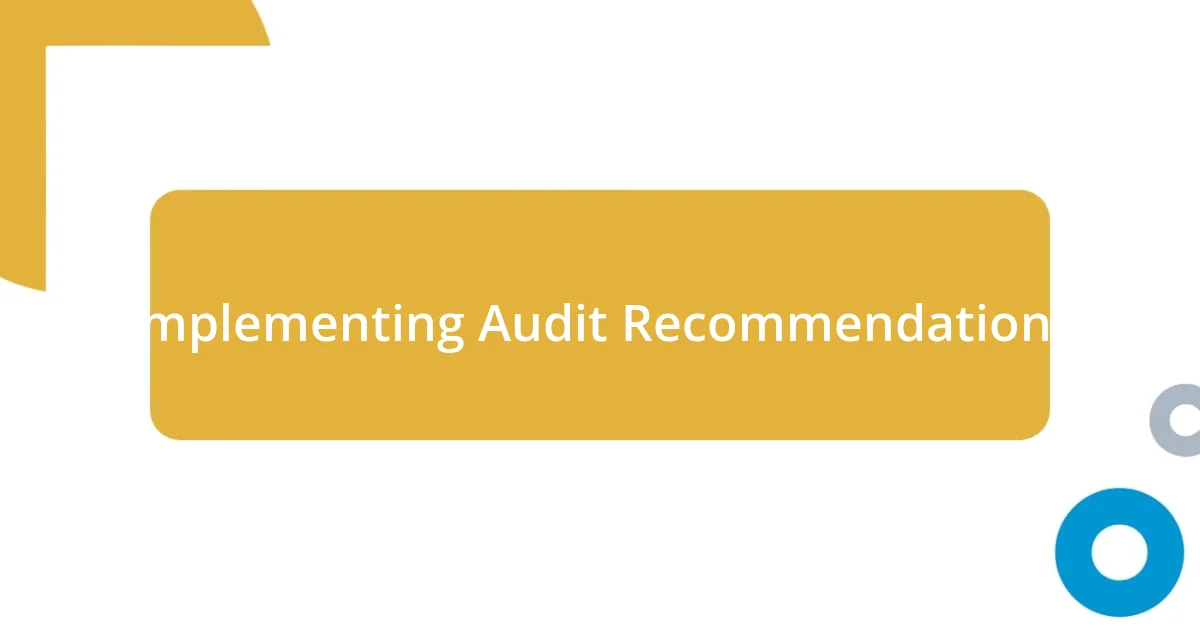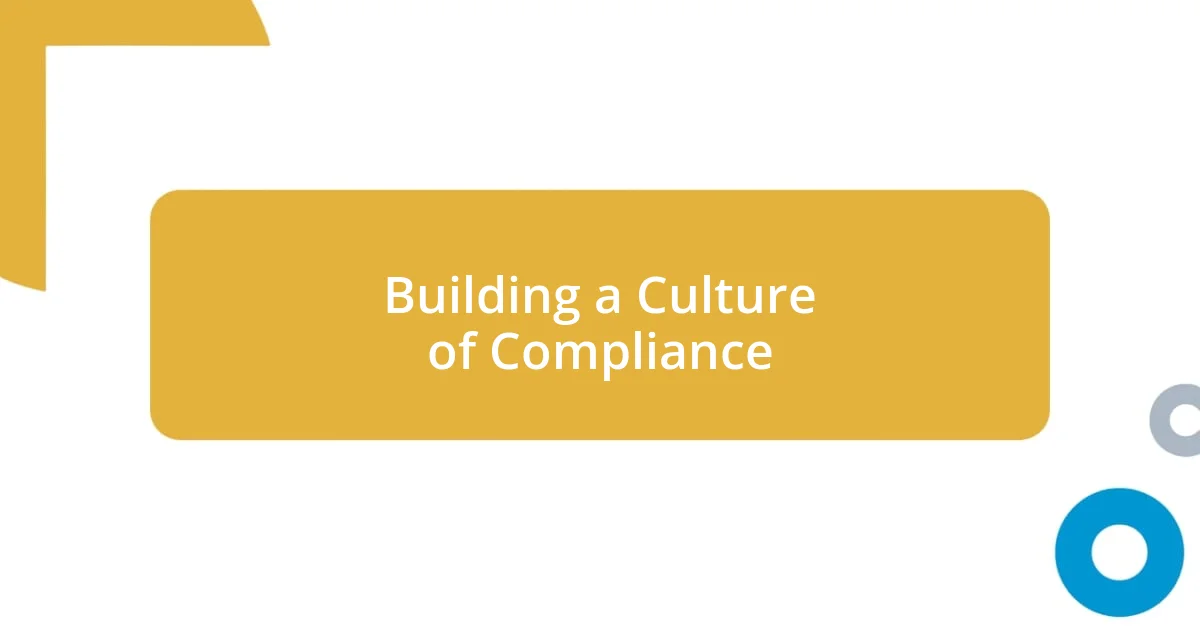Key takeaways:
- Licensing audits serve as essential tools for assessing compliance, uncovering savings, and fostering a culture of accountability within organizations.
- Preparation, including thorough documentation and team engagement, is crucial to navigating audits successfully and optimizing software investments.
- Building a culture of compliance involves transparency, continuous learning, and collaboration, empowering teams to take ownership of software management.

Understanding Licensing Audits
Licensing audits can feel like a daunting process, but they have a specific purpose. I remember the first time I was faced with one; my heart raced with anxiety. However, understanding that these audits are essentially a review of compliance with licensing agreements helped me view it from a different perspective.
These audits not only assess compliance but also provide a valuable opportunity for organizations to evaluate their software use and licensing practices. Have you ever wondered how much software you’re actually using versus what you’re paying for? I learned through my experience that sometimes you can uncover significant savings by being proactive about your software management.
Perhaps one of the most striking aspects of licensing audits is the sense of accountability they instill within a team. When I reflected on my own practices post-audit, I realized how important it is to foster a culture of transparency regarding software use. This experience encouraged me to engage my colleagues in discussions about licensing, turning feelings of anxiety into a collaborative effort towards improvement.

Importance of Licensing Compliance
Staying compliant with licensing agreements is crucial for any organization. I learned this vividly when a colleague experienced a hefty fine due to unlicensed software usage. That incident served as a wake-up call for our team. It wasn’t just about avoiding penalties; it was about respecting the work of those who create software and ensuring we are maximizing our investments.
Understanding the implications of licensing compliance has led me to see its importance from several angles:
- Risk Mitigation: Non-compliance can result in hefty fines and legal repercussions.
- Cost Savings: Regular audits can uncover unused licenses, which can lead to significant savings.
- Enhanced Reputation: A commitment to compliance reflects positively on your organization, building trust with clients and partners.
- Operational Efficiency: Compliance encourages teams to assess their actual needs versus what they pay for.
- Employee Accountability: Promoting a culture of compliance fosters responsibility and team engagement around proper software usage.
Reflecting on these aspects, I feel energized when discussing licensing compliance with my colleagues—it’s no longer an obligation but an opportunity for growth and collaboration.

Preparing for a Licensing Audit
When it comes to preparing for a licensing audit, the first step is gathering all your documentation. I recall one time when I nearly panicked because I couldn’t locate the licensing agreements. This experience taught me the importance of organizing files in a central location. Having everything at your fingertips not only eases stress but also allows you to present your case clearly during the audit.
Next, I suggest conducting a self-audit before the official one. This process can be an eye-opener. I once discovered that our department was underutilizing several software licenses. By evaluating usage against our agreements, I found ways to optimize our software investments. It’s remarkable how much clarity this exercise can bring, as it allows you to address any discrepancies proactively.
Finally, engaging your team in the preparation process creates transparency. I remember holding a meeting to discuss the upcoming audit, and it transformed the atmosphere from apprehensive to collaborative. Sharing knowledge about licensing not only informed everyone but also encouraged accountability. Team members left with a greater sense of ownership over software management, letting us stride into the audit with confidence.
| Preparation Steps | My Experience |
|---|---|
| Gather Documentation | Almost panicked over misplaced licensing agreements; now, it’s a must-do. |
| Conduct a Self-Audit | Found unused licenses by evaluating usage; great way to optimize investments. |
| Engage the Team | Transformed apprehension into collaboration during our prep meetings. |

Common Audit Findings and Issues
One of the most common findings during licensing audits is the unexpected shortage or surplus of software licenses. I remember the feeling of disbelief when our audit revealed we were paying for ten licenses that went unused. This not only highlighted a gap in our software management strategy but also led me to ponder: how often do we inadvertently waste resources? This experience really pushed me to advocate for thorough usage assessments.
Another prevalent issue is the lack of documentation related to software installations and agreements. During one audit, I found myself frantically searching for proof of our licenses for a crucial tool. The embarrassment of not being prepared taught me a valuable lesson: documentation is not just a formality; it’s the backbone of compliance. Have you ever felt that panic? It’s a reminder of the importance of keeping everything organized and accessible.
Furthermore, inconsistencies between recorded licenses and actual installations often pop up. In my case, we discovered some software running in multiple locations without proper licensing. This situation created unease, as it raised compliance concerns for the team. I asked myself, how could we let this happen? Addressing these discrepancies has since become a priority in our operations—ensuring accountability in software management has changed the game for us.

Implementing Audit Recommendations
Once the audit is complete and recommendations are provided, implementation becomes crucial. I vividly recall grappling with an auditor’s suggestion to streamline our license allocation process. Initially, I perceived it as just another task, but adopting a strategic approach opened my eyes to the efficiency gains we could achieve. Implementing recommendations can be a transformative experience, leading to better resource management and ultimately saving costs.
I found it helpful to prioritize these recommendations based on their potential impact. For instance, after an audit, we were advised to conduct quarterly licensing reviews. At first, it felt overwhelming. However, once I organized these reviews into our calendar, the process became manageable and effective. It’s all about creating a rhythm—how often do we let important tasks slip through the cracks simply because they’re not scheduled?
Communication is also vital when rolling out changes. I remember introducing new protocols to my team and facing skepticism at first. By explaining the rationale behind these adaptations and actively soliciting feedback, I turned their resistance into enthusiasm. Have you ever noticed how much smoother implementation goes when everyone understands the bigger picture? I’ve seen firsthand that involving the team not only eases the transition but also fosters a culture of accountability and ownership.

Building a Culture of Compliance
Building a culture of compliance goes beyond mere adherence to rules; it’s about fostering an environment where everyone feels responsible. I recall a time when our team casually disregarded license management. I wondered, how could we expect compliance when everyone seemed to think it wasn’t their job? This prompted a shift in how I communicated about compliance—not as a burden, but as a shared commitment to our organisation’s integrity and efficiency.
I’ve found that leading by example is crucial in this journey. When I started taking the time to review our software usage publicly with the team, I noticed a significant change. Suddenly, conversations about compliance became more frequent, and colleagues began to share their experiences and challenges. It’s amazing how an open dialogue can transform perceptions. Have you ever witnessed a simple act of transparency spark a broader movement towards accountability?
Cultivating a culture of compliance also means providing continuous learning opportunities. I introduced informal training sessions about licensing and its implications, and you wouldn’t believe the interest it generated. One day, a junior team member approached me with a brilliant idea for improving our documentation process after attending one of those sessions. Could it be that empowering individuals not only fosters compliance but unleashes innovation too? That’s a powerful reminder of why building a compliant culture is essential—it inspires collective ownership and creativity.

Lessons Learned for Future Audits
The experience of going through licensing audits has taught me the importance of preparation. In one particular audit, I remember the frantic days leading up to it, scrambling to gather documents and clarify processes. After that, I implemented a checklist well ahead of time, ensuring all relevant materials were easily accessible. Doesn’t it make sense to be proactive rather than reactive? A little foresight can save so much stress.
Another lesson I learned was the power of data-driven insights. I used to see compliance metrics as mere numbers—but after one audit, I realized they revealed patterns and trends that informed our practices. For example, tracking license usage over time highlighted inefficiencies we hadn’t noticed. Have you ever had that moment when the data clicks into place and sparks a change? Turning those insights into action can strengthen future audits and improve overall operations.
Lastly, I discovered the value of involving the right stakeholders early in the process. I once held a meeting with cross-departmental teams to discuss audit findings; what surprised me was how different perspectives led to innovative solutions we hadn’t considered. Engaging those who directly interact with the systems leads to deeper understanding and commitment. Isn’t it interesting how collaboration can illuminate blind spots? Bringing diverse viewpoints into future audit preparations creates a rich environment for improvement.












